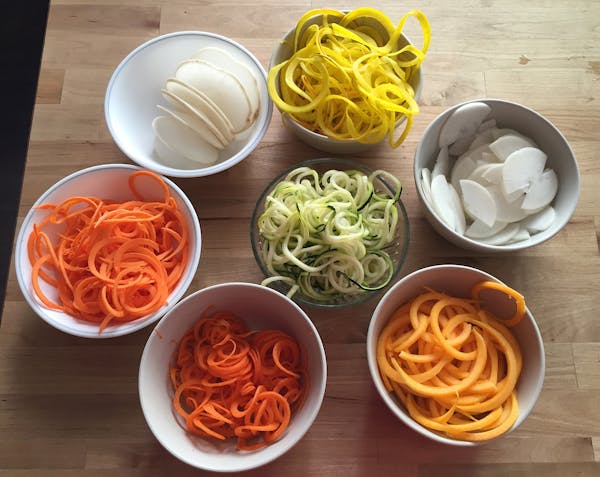After making a dozen dishes using the spiralizer, here's what we learned:
Go for the biggest spiralizer: There are a number of options on the market, but the one that's most versatile (with the best results) is a tabletop spiralizer with three blades by Paderno World Cuisine (see above). The device adheres to a countertop with suction cups and is a cinch to clean. The blades can make flat ribbon noodles, thin spaghetti/linguine or wider fettuccine. A more expensive version comes with a fourth blade that makes tiny angel hair strands. Available on Amazon.com for $25.76 (3-Blade Basic) or $47.99 (4-Blade Pro).
Some spiralized dishes look better than they taste: It might look like a bagel or a pizza crust, but it's still just vegetables. Adjust your expectations, however, and you will appreciate the flavors that veggies can add to your formerly carb-heavy dishes.
But if it looks like spaghetti, it still acts like spaghetti: You can still stain your shirt with dripping sauce from a dangling zucchini noodle. With especially long vegetables, you'll want to break apart the spirals every few inches or so, lest you end up with one giant noodle that's impossible to load on your fork.
Experiment: Didn't like the look of the butternut squash at the market? Try sweet potato instead. Swap cucumber for zucchini, or even a vegetable you've never tried. Just note that not all veggies are created equal. Some can be enjoyed raw, while others need varying time over heat. Also pay attention to water content; zucchini, for instance, can quickly turn a thick sauce watery. But some advance prep of quickly boiling the strands and then draining them could save your sauce.
Get your phone ready: Many spiralized dishes come out Instagram-ready. Even when you're asking yourself why you just spent 45 minutes spiralizing eight vegetables for a salad, the final result can be stunning. Best to save the more impressive recipes for when you have company. Or just post photos online and receive all the likes.
Sharyn Jackson
Taylor Swift bill is signed into Minnesota law, boosting protections for online ticket buyers
Harvey Weinstein is back at NYC's Rikers Island jail after hospital stay

Katy Perry and Rihanna didn't attend the Met Gala. But AI-generated images still fooled fans
Music Review: Kings of Leon electrify with new album that nods to the past, 'Can We Please Have Fun'

